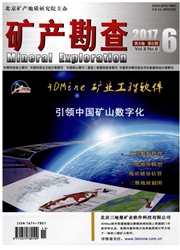

 中文摘要:
中文摘要:
罗维钨多金属矿床是近年来广西第四地质队在桂西南西大明山地区新发现的一个具大型规模的夕卡岩型矿床,钨多金属矿化主要产在深部隐伏岩体外接触带的夕卡岩中,矿体呈似层状平行产出。文章对成矿流体包裹体的初步研究表明,区内成矿流体包裹体主要有NaCl-H2O型和NaCl—CO2-H2O型两种类型,成矿流体主要为中-高温(200~360℃)、中低盐度(2.00%-9.00%NaCleq)和中低密度(0.621~0.987g·cm^-3)流体,成矿过程中可能存在深部偏高盐度流体与浅部偏低盐度流体的混合,矿床形成的平均压力为108.9×10^5Pa,计算得出的平均成矿深度约7.86km。结合区域成矿分带特征进一步提出,罗维钨多金属矿床与深部隐伏岩体有关,属岩浆流体与地层中的钙质岩石发生双交代的产物。
 英文摘要:
英文摘要:
The Luowei tungsten polymetallic deposit was a newly found large-sized deposit in Xidamingshan area by the No. 4 Gold Geological Party of Guangxi. The tungsten polymetallic mineralization mainly occurs outside contact zone of the deep intrusive bodies, and the ore bodies are distributed as stratoid form.The preliminary studies of ore-forming fluid inclusions suggest that the two types of fluid inclusions, i.e., NaCl-H2O type and NaCl-CO2-H2O type, are related to mineralization. Ore-forming fluid is mainly in medium-high temperature ( 200- 360℃) and medium-low salinity ( 2.00% - 9.00% NaCleq ) and medium-low density ( 0.621 - 0.987 g·cm^-3 ). The mixing of deep high salinity fluid and shallow low salinity fluid may occur in the process of mineralization. The average pressure of ore deposit formation is 108.9×10^5Pa,and the calculated average metallogenie depth is about 7.86 km. In combination with regional mineralization zoning charaeteristies, it was eoneluded that Luowei tungsten polymetallie deposit was related to the deep intru- sive bodies, and formed in the dimetasomatism of magmatie fluid and calcareous rock in stratum.
 同期刊论文项目
同期刊论文项目
 同项目期刊论文
同项目期刊论文
 期刊信息
期刊信息
